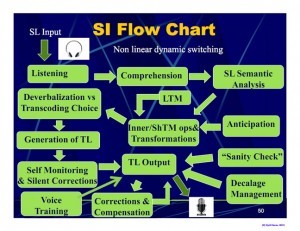A translator Simultaneous can orchestrate an accurate and transparent discussion between people who do not speak the same language in a real-time setting. In a world that has become a global village, the necessity for a translator is critical in bridging the communication gap between those who run governments, corporations, research, education, and other institutions.

In most cases, translation is required as soon as feasible during a summit or conference. It is achieved through the use of a highly qualified interpreter using the simultaneous interpretation method.
WHAT IS A SIMULTANEOUS TRANSLATOR, AND HOW DOES IT WORK?
Simultaneous Interpretation or Translation is achieved when a person, after hearing only a few words uttered in one language, can pronounce what is being said to a target audience or individual in another language flawlessly and in the middle of a conversation.
It necessitates a high level of competence and a big pool of information from which the interpreter may draw instantly, putting simultaneous interpretation at the top of the list of the most challenging forms of human communication. Moreover, it all happens right in the middle of a conversation, with a lag time of only a few seconds between what’s being said and what’s being spoken.
The Translator works in a soundproof room and uses headphones to listen to the source speaker. The Translator relays information to the target listener or listeners using a microphone when the source speaker speaks. Because the process is so hectic and taxing, the Translator typically works in 30-minute stints, translating up to 4,500 words in that time.
What is the process of simultaneous interpretation (or simultaneous translation)?
First, it is critical to understand that you will require an interpreter, which means that a person, who can be a volunteer or a professional, paid interpreter, must translate the speaker’s (pastor, presenter, professor, attorney, etc.) speech in real-time. Despite enormous technological advances, there is still no software capable of performing reliable simultaneous interpretation because it requires translation of context and meaning of sentences – not just random words.
As a result, a simple system consists of receivers for the audience, together with their accompanying headphones, and a transmitter and microphone for the interpreter. The idea is for the audience to comprehend the speaker while speaking rather than stop and wait for the speech to be translated. Instead, the interpreter listens to the speaker and makes simultaneous interpretation, sometimes known as real-time simultaneous translation. The interpreter’s microphone is attached to the transmitter, which transmits a signal to the personal wireless receivers, allowing everyone to listen to the interpretation in their language through headphones.
One transmitter is required for each language in FM systems. FM transmitters can be portable (also known as tour-guide or belt-clip transmitters) and run on batteries. At the same time, permanent transmitters (also known as base or table transmitters) are typically used for events at fixed sites where the interpreter does not need to move.
A United Nations conference is a typical example of simultaneous interpretation. It is usual to see international leaders using headsets at these sessions. While the main speaker delivers their speech in real-time, it is being interpreted for the target language recipient wearing a headset. The interpreter translates the words and expresses the speaker’s tone, intention, and emotion.
The interpreter must display a high level of professionalism and diplomacy during arguments or confrontational speaking by communicating the correct meaning of the message as it is stated. When dealing with individuals and two or more completely different languages, the position of an interpreter is particularly difficult.
Simultaneous interpretation is provided in real-time on the scene (it is life). The interpreter must concentrate and listen at all times, analyzing and presenting the information and concepts precisely as they are intended when they are uttered. People frequently babble, putting a tremendous amount of stress and pressure on simultaneous interpreters to keep up.
The interpreter translates the message as rapidly as they can into the target language. While the source language speaker speaks constantly, the Translator, who is usually seated in a soundproof booth, receives the speech through their headset, speaks into a microphone, and transmits the target language to the recipient’s headset.

Simultaneous interpretation can be difficult.
The Challenges of Simultaneous Interpretation
Introduction: Simultaneous interpretation, the process of orally translating spoken language in real-time, is a complex and demanding task. Interpreters must possess exceptional language skills, cognitive abilities, and a deep understanding of both the source and target languages. In this article, we will explore the challenges faced by simultaneous interpreters and shed light on the intricacies of this demanding profession.
- Multitasking and Mental Agility: Simultaneous interpretation requires interpreters to listen to the speaker while simultaneously rendering their words into the target language. This demanding cognitive process necessitates exceptional multitasking skills and mental agility. Interpreters must process information rapidly, comprehend the speaker’s message, and produce an accurate and coherent interpretation in real-time. Juggling these tasks simultaneously can be mentally taxing and requires intense concentration and focus.
- Language Peculiarities and Idiomatic Expressions: Interpreting colloquialisms, idiomatic expressions, and culturally specific language poses a significant challenge. These language peculiarities may not have direct equivalents in the target language, requiring interpreters to quickly find suitable linguistic alternatives that convey the intended meaning. Striking a balance between faithfulness to the speaker’s message and ensuring audience comprehension can be a delicate task.
- Fast-paced Speech and Accents: Speakers may deliver their presentations at a rapid pace, making it challenging for interpreters to keep up and render a coherent interpretation. Additionally, speakers with strong regional accents or distinct speaking styles can further complicate the task, as interpreters must decipher their words accurately and convey their message clearly. Quick thinking and adaptability are essential to maintain the flow of interpretation despite challenging speech patterns.
- Subject Matter Expertise: Simultaneous interpreters often work in a variety of domains, ranging from business and politics to science and technology. They must possess a broad knowledge base and stay updated on industry-specific terminology and current events. Interpreting specialized terminology accurately and confidently requires continuous learning and research to ensure precision and clarity in interpretation.
- Psychological and Emotional Demands: Simultaneous interpretation can be psychologically and emotionally demanding. Interpreters often work in high-pressure environments, such as conferences, meetings, or live broadcasts, where accuracy and professionalism are paramount. The pressure to perform flawlessly in real-time can lead to stress, fatigue, and performance anxiety. Managing stress and maintaining composure is crucial to ensure consistent and accurate interpretation.
- Equipment and Technical Challenges: Simultaneous interpretation often relies on specialized equipment, such as soundproof booths, microphones, and headsets. Working with this equipment effectively requires familiarity with the technology and the ability to troubleshoot technical issues that may arise during interpretation. Adaptability to different interpreting environments and the ability to quickly adapt to technical challenges is essential for a smooth interpretation process.
- Maintaining Neutrality and Impartiality: Interpreters must remain neutral and impartial, faithfully conveying the speaker’s message without injecting personal opinions or biases. This requires exceptional professionalism and the ability to separate personal beliefs from the interpretation process. Maintaining objectivity while interpreting sensitive or controversial topics can be particularly challenging, requiring interpreters to navigate linguistic nuances and cultural sensitivities.
- Continuous Professional Development: To meet the demands of simultaneous interpretation, interpreters must engage in continuous professional development. This includes staying updated on language developments, refining interpreting techniques, and expanding subject matter expertise. Attending workshops, conferences, and networking with other interpreters fosters ongoing skill development and helps interpreters stay at the forefront of their profession.
Conclusion: Simultaneous interpretation is a challenging task that requires exceptional language skills, cognitive abilities, and subject matter expertise. The demands of multitasking, language peculiarities, fast-paced speech, and technical challenges make this profession mentally and psychologically demanding. However, skilled interpreters who possess adaptability, professionalism, and a commitment to ongoing learning can overcome these challenges. Despite the difficulties, simultaneous interpretation plays a crucial role in facilitating cross-cultural communication, bridging language barriers, and enabling effective communication on a global scale.
Simultaneous interpreting typically necessitates the use of two interpreters. It is because the task is quite demanding. The interpreter must pay close attention, comprehend the word, recall the target language, and discover linguistic solutions. Compared to a pure verbatim translation of spoken words, sentence patterns are often changed when translated to the target language, and more thought is necessary to communicate the intended meaning. As you might expect, this is a difficult task!
Simultaneous interpretation is mentally as well as physically draining. When translating, more than 20 different cognitive skills are required. In addition, listening while others speak, analyze, and convey the content, ideas, and tone necessitates a high concentration and focus. According to studies, translators spend up to 75% of their time speaking one language while listening to another.
As a result, interpreters use two languages the majority of the time. They are listening to the source language while simultaneously monitoring their target language communication. They must understand sophisticated terminology and have a strong command of the English language while dealing with legal, medical, geological, financial, and economic matters, to mention a few. They must do so not only at an advanced level in one language but in two.
Simultaneous interpreters are typically paired up.
After around 30 minutes, it becomes difficult to maintain the essential focus and concentration, and accuracy suffers. The speech progresses swiftly, and translators rarely get the chance to restate their remarks if they think a better word choice would be better after all.
What’s the big deal?
By breaking down language barriers, language services such as interpretation ensure correct understanding and effective communication. Simultaneous interpretation allows participants to understand what the speaker is saying nearly immediately.
To Read more article, just click on: https://24x7offshoring.com/blog/
